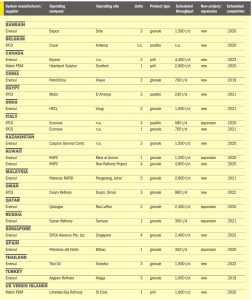
Sulphur forming project listing 2020
Sulphur ’s annual listing of new or recently completed sulphur forming projects worldwide covers both new sour gas and refinery sulphur forming projects as well as upgrades at existing units.

Sulphur ’s annual listing of new or recently completed sulphur forming projects worldwide covers both new sour gas and refinery sulphur forming projects as well as upgrades at existing units.
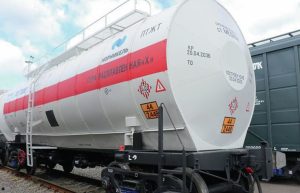
US crude production dropped rapidly during April and May, but figures released by the Energy Information Administration (EIA) showed that this had plateaued and there have been some well reactivations and drawdowns from crude stocks. Total production curtailments in North America were more than 2.5 million bbl/d in May. ConocoPhillips Chairman and CEO Ryan Lance said in remarks to the media that a return to pre-outbreak production levels of 13 million bbl/d looked “pretty difficult”, although a recovery to 11 million bbl/d or possibly as high as 12 million bbl/d would be possible, depending upon OPEC moves. About one third of the company’s production was shut in as of the start of June – some 400,000 bbl/d. Lance argued that low cost shale oil resources still exist in the US, but there will be pressure on companies to reduce capital spending. The Covid19 outbreak has had a major impact in investment announcements, with a large number of project delays in the US due to uncertainty over future demand levels. Planned US exploration and production expenditure is down by 50% for the second half of 2020, while the rig count was down 60% on February.

Although amine solution foaming problems have been studied and reported extensively, direct correlations about the root causes of foaming have not been completely established. This article approaches the problems of foaming from a different perspective, rather than theoretical discussions, the topic is centred exclusively on Amine Experts’ field-related experiences with amine foaming episodes.
The Sulphur Institute (TSI) has announced the selection of Ron Olson as its agronomist. Olson has over 30 years of experience as an independent consulting agronomist as well as 15 years with Cargill and The Mosaic Company. His agronomic consulting company worked directly with farmers and agricultural retailers offering custom soil sampling and soil analysis, and crop management expertise. The company pioneered the implementation of using precision agriculture tools for taking soil samples on a 2.5 acre grid, converting that data to computer maps and linking that data to GPS/GIS technology to develop crop management programs to achieve maximum economic yields. With Cargill and Mosaic he served as Research and Development Manager and led the team that developed the MicroEssentials™ suite of products., which has grown to become the leading commercial sulphur enhanced fertilizer sold globally.

Meena Chauhan , Head of Sulphur and Sulphuric Acid Research, Argus Media, assesses price trends and the market outlook for sulphur.
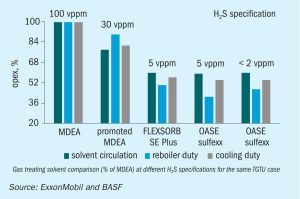
The removal of hydrogen sulphide (H2 S) has become increasingly important as the oil and gas industry moves towards more efficient and sustainable production of lower emission clean fuels. BASF and ExxonMobil* have jointly developed a proprietary amine, OASE® sulfexx™ , to help refiners and gas processors achieve sulphur removal targets while reducing their carbon footprint via lower energy consumption. This new solvent technology is suitable for low and high pressure applications and shows superior performance characteristics over generic and promoted MDEA formulations, as well as sterically hindered amines such as FLEXSORB™ SE and SE Plus.
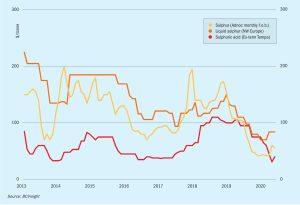
Sulphur demand losses for production of phosphoric acid are forecast at 2.2 million t/a in 2020. Factoring in demand gains in markets such as Morocco, the sector is expected to see a drop of 800,000 t/a in 2020. Recovery is forecast from 2021 with a 2 million t/a increase forecast.

There was a rapid increase in sulphuric acid demand for copper, uranium and nickel leaching from 1995-2015, but over the past few years growth in this sector has slowed dramatically. Now however there are signs that demand is starting to pick up again with several new projects under development.
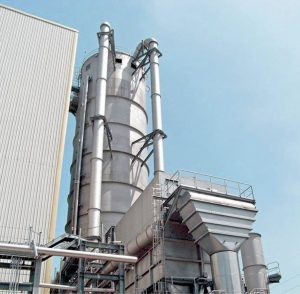
Kreber’s R&D department has been researching the prilling of sulphur in pursuit of the ideal process. In this article, T. Nieboer of Kreber recounts the history of prilling up to today, tracing the developments and highlighting the challenges that still remain.
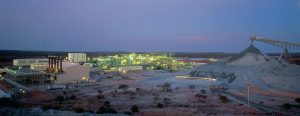
Sulphur demand in Australia has been boosted by the restart of the nickel leaching plant at Ravensthorpe, and new HPAL projects are under development, but a slew of new phosphate projects are not scheduled to consume more acid domestically.